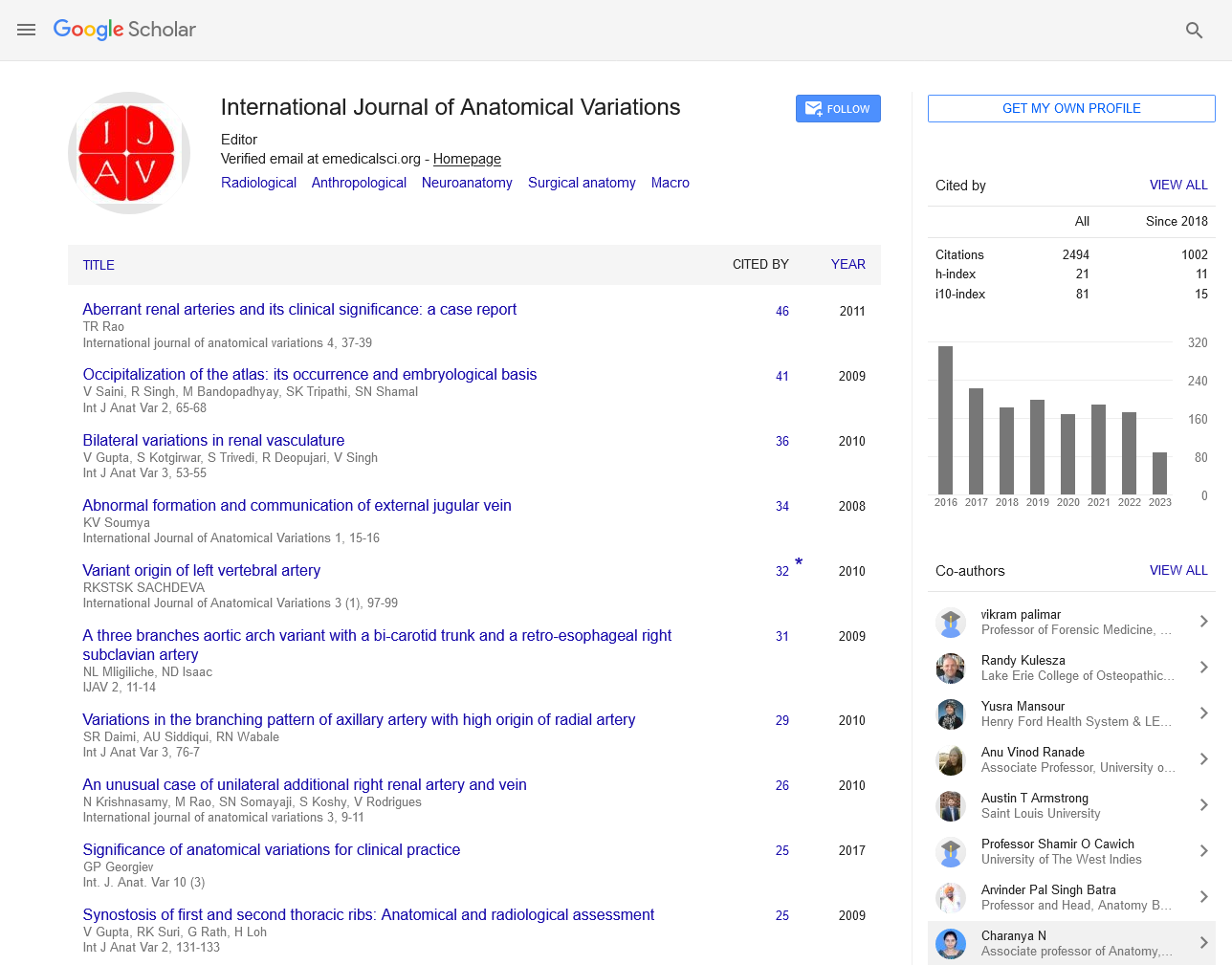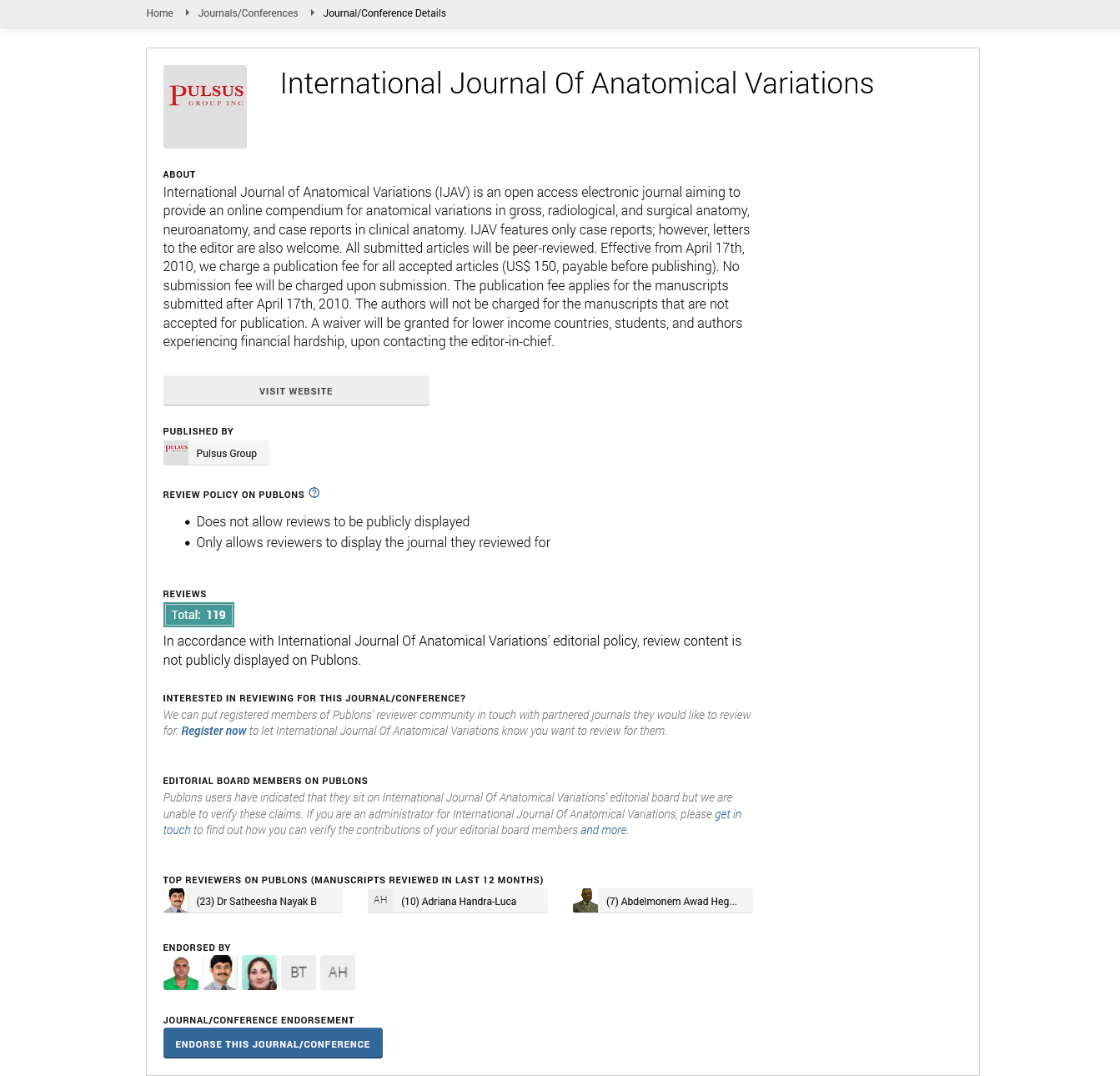Embryology Insights into Early Human Development and Clinical Applications
Received: 01-Apr-2025, Manuscript No. ijav-25-7669; Editor assigned: 04-Apr-2025, Pre QC No. ijav-25-7669 (PQ); Reviewed: 21-Apr-2025 QC No. ijav-25-7669; Revised: 26-Apr-2025, Manuscript No. ijav-25-7669 (R); Published: 30-Apr-2025, DOI: 10.37532/13084038.18(4).503
Citation: Hendry J. Embryology Insights into Early Human Development and Clinical Applications. Int J Anat Var. 2025; 18(4): 774-775.
This open-access article is distributed under the terms of the Creative Commons Attribution Non-Commercial License (CC BY-NC) (http://creativecommons.org/licenses/by-nc/4.0/), which permits reuse, distribution and reproduction of the article, provided that the original work is properly cited and the reuse is restricted to noncommercial purposes. For commercial reuse, contact reprints@pulsus.com
Abstract
Embryology, the branch of biology that studies the formation, early growth, and development of living organisms, provides critical insights into human development. This research article explores key stages of human embryogenesis, the underlying molecular and genetic mechanisms, and the relevance of embryological knowledge in medical science. It also examines advancements in imaging technologies, stem cell research, and the impact of embryology in understanding congenital disorders. The discussion concludes by highlighting ethical considerations and future directions in embryological studies.
INTRODUCTION
Embryology is the study of embryos and their development, encompassing the period from fertilization to the fetal stage [1]. Human embryology integrates molecular biology, genetics, anatomy, and pathology to understand how complex organisms arise from a single cell. Its applications are extensive, ranging from reproductive medicine to developmental biology and congenital disease diagnosis. Embryology, the scientific study of embryos and their development, offers profound insights into the origins and formation of human life. From the moment of fertilization to the establishment of complex organ systems, embryology reveals the intricate biological processes that transform a single cell into a fully formed organism. This field not only deepens our understanding of human anatomy and physiology but also provides the foundation for diagnosing and managing developmental disorders [2]. In recent decades, advances in molecular biology, genetics, and imaging technologies have revolutionized embryological research. These developments have enabled scientists and clinicians to unravel the complex signaling pathways and gene interactions that drive early development. As a result, embryology has become increasingly relevant to clinical practice, particularly in areas such as reproductive medicine, prenatal diagnosis, and regenerative therapies. Moreover, understanding embryonic development is critical for identifying the origins of congenital anomalies, many of which arise during the early stages of gestation. By studying the mechanisms of normal and abnormal development, embryology contributes to both preventative strategies and therapeutic interventions [3].
HISTORICAL BACKGROUND
The scientific study of embryology dates back to Aristotle, who proposed early theories on reproduction. However, modern embryology began in the 19th century with the advent of microscopy, leading to the discovery of fertilization and early cell division. The 20th century saw the integration of genetics and embryology, culminating in the field of developmental biology [4].
STAGES OF HUMAN EMBRYONIC DEVELOPMENT
Fertilization occurs when a sperm cell fuses with an ovum to form a zygote. This process triggers metabolic and genetic activation of the oocyte and initiates embryogenesis. The zygote undergoes rapid mitotic divisions, known as cleavage, resulting in a multicellular morula. This structure develops into a blastocyst, characterized by the presence of an inner cell mass and a fluid-filled cavity. During gastrulation, the blastocyst reorganizes into a trilaminar structure comprising ectoderm, mesoderm, and endoderm. This process establishes the body axis and lays the groundwork for organogenesis. The ectoderm forms the neural plate, which folds to become the neural tube—precursor to the central nervous system. From weeks 4 to 8, major organs begin to form. Organogenesis involves complex signaling pathways and gene regulation [5].
MOLECULAR AND GENETIC MECHANISMS
Embryonic development is tightly regulated by gene expression. Key genes include HOX, PAX, and SHH, which direct pattern formation and cell differentiation. Pathways such as Wnt, Notch, and BMP play critical roles in cellular communication and tissue development. Disruptions can lead to developmental abnormalities.
CLINICAL APPLICATIONS
Knowledge of embryology aids in the early detection of congenital anomalies through ultrasound and genetic screening. Understanding embryo development is essential in assisted reproductive technologies. Embryologists assess embryo viability and select those with the best developmental potential. Stem cells derived from embryos have the potential to regenerate damaged tissues. Embryology informs protocols for stem cell differentiation.
CONGENITAL ANOMALIES
Errors during embryogenesis can result in congenital malformations such as neural tube defects, limb abnormalities, and cardiac anomalies. Studying these defects helps develop preventive and therapeutic strategies.
ADVANCES IN TECHNOLOGY
Technologies like 3D imaging, CRISPR gene editing, and single-cell RNA sequencing have transformed embryological research. These tools allow precise observation and manipulation of developmental processes.
ETHICAL CONSIDERATIONS
The use of human embryos in research raises ethical concerns, particularly regarding embryo destruction and genetic modification. Regulatory frameworks differ globally, and ethical discussions continue to evolve alongside technological capabilities.
FUTURE DIRECTIONS
Emerging areas include organoid development, artificial womb technology, and personalized embryology using AI. Further integration of bioinformatics and developmental biology promises new insights into human development and disease.
CONCLUSION
Embryology remains a cornerstone of developmental biology and medicine. Its integration with modern genetic and technological advances not only enhances our understanding of human life’s earliest stages but also paves the way for innovative medical therapies. Ongoing research, guided by ethical responsibility, holds immense potential for addressing fundamental biological questions and clinical challenges.
REFERENCES
- Shigeru H. Glomerular Neovascularization in Nondiabetic Renal Allograft Is Associated with Calcineurin Inhibitor Toxicity. Nephron. 2020; 144 Suppl 1:37-42.
- Konschake M, Olewnik Ł. Unknown variant of the accessory subscapularis muscle?. Anat Sci Int. 97(1), 138-142.
- Youdas JW. Bilateral presence of a variant subscapularis muscle. Int J Anat Var. 2017; 10(4):79-80.
- Janda P, Pękala J, Malinowski K. The subscapularis muscle‐a meta‐analysis of its variations, prevalence, and anatomy. Clin Anat. 2023; 36(3):527-541.
- Jacob SM. Bilateral presence of axillary arch muscle passing through the posterior cord of the brachial plexus. Int. J. Morphol., 27(4):1047-1050, 2009.
Indexed at,, Google Scholar, Crossref
Indexed at, Google Scholar, Crossref
Indexed at, Google Scholar, Crossref






